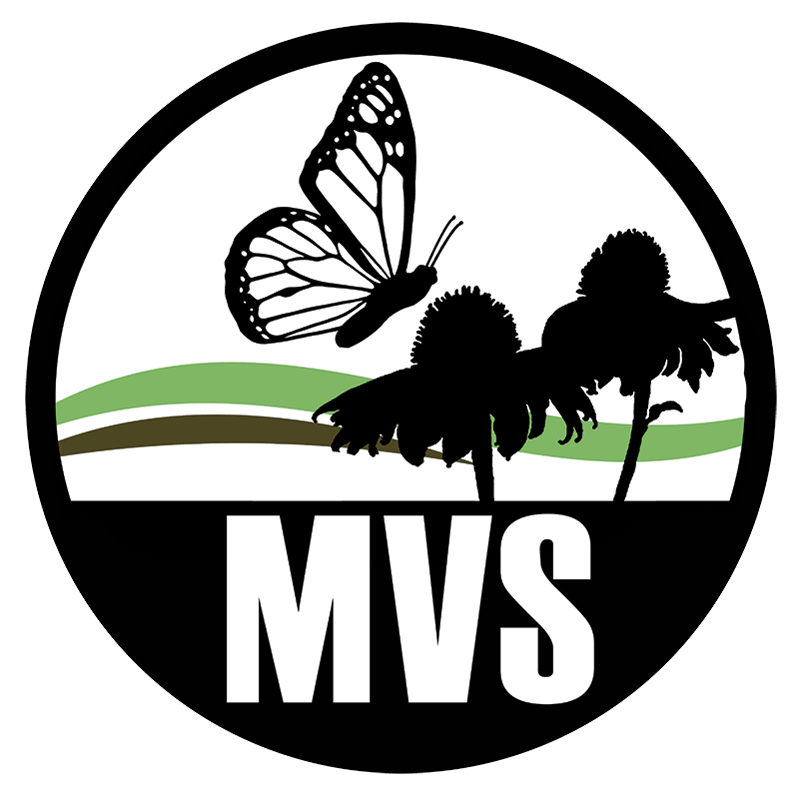
-
Lower Long Term Maintenance Costs:
A native landscape in a solar array takes time to develop and requires patience along with careful management the first few years. However, if a solar site is prepared and planted correctly, and necessary maintenance is performed, it lowers the long-term overall O&M cost. Solar sites offer unique challenges that require the necessary experience and equipment to implement a proper management plan. No vegetation is ever maintenance free.
-
Greater Community Reception to Development:
Some of the public benefits of a native pollinator friendly solar site include increased pollinator presence at the site and very commonly surrounding area orchards and gardens within a three-mile radius of the site. The deep root systems of native habitat create channels sometimes over 12 feet deep in which rainwater flows, replenishing the water table as it’s filtered by the soil. Critical habitat on the site is being provided for songbirds, native insects and butterflies, and the opportunity for honeybee apiaries to be installed at the array, creating agricultural use of the site.
-
Soil Stabilization & Reduced Storm Water Run Off:
Turf grass frequently requires application of fertilizers throughout the life of the array, 20-25 years (native plants do not) and the shallow root systems of turf grasses do not promote water retention, instead often creating water run-off and erosion challenges. No useful habitat is created on a turf-planted site and there isn’t any forage for pollinators. Drought years can cause die-off due to the shallow root system of turf, creating acres of exposed soil for invasive species of many heights to establish.
-
Giving Back to the Land, Local Farms & Our Food Source:
By incorporating native and pollinator vegetation on your site you are using the full potential of the soil and providing critical habitat for pollinators.

_JPG.jpg)

WHY CHOOSE POLLINATOR HABITAT FOR YOUR SOLAR SITE?
WHAT WE OFFER
PRE-CONSTRUCTION SEEDING
When determining seeding schedule for your project, a lot of times we will push for Pre-Construction seeding if possible and seed mix allows. This works well with a variety of mixes to ensure quick establishment and alleviate issues with sediment and erosion control. Pre-Construction seeding is not only beneficial from the vegetation establishment standpoint, but also from a cost standpoint as well. Equipment is much easier to be utilized onsite when the site is open to install seed, till, de-compact, straw mulch etc., which ultimately means the crew can be more efficient with this option. For Pre-Construction seeding, we figure about 30-50% of the site will need to be touched up during Post Construction on the heavily trafficked area such as panel rows, site roads etc.
.jpg)
Pre-Construction drill seeding on a project prior to piles and panels being installed.
Completed Post Construction seeding of ERNMX-186 under panels, and ERNMX-153 along with straw mulch in between the rows in array.
.jpg)

POST CONSTRUCTION SEEDING
Not every project plans or allots for Pre-Construction seeding, so we offer Post Construction seeding as well. Also, depending on the specific seed mix your project calls for, sometimes Post Construction is the more beneficial option, especially when it comes to pollinator mixes. Unlike fescues or clover mixes, pollinator mixes are a little slower establishing and cannot handle the high traffic of a construction site. Because of that reason, we recommend Post Construction seeding when it comes to a full pollinator mix in the array. Post Construction seeding can be more time sensitive due to needing to navigate pilings, panels and etc.. It is extremely important when planning for your vegetation you take into consideration things such as panel height and row spacing as these can really help contribute to what can and can’t be done on your site when it comes to not only seeding but maintenance for the duration of the project as well.
Ashton drill seeding ERNMX-153 Northeast Native Wildflower & Grass Mix post construction.
SOME CONSIDERATIONS
DECOMPACTION
Compaction from construction equipment is a major issue when establishing a new seeding. It causes the soil to tighten up which does not allow water infiltration, eliminates void space for air exchange, and makes it very difficult for new seedlings to penetrate the soil with their roots. This condition often results in a failed establishment. Decompaction is a vital step in the process for successful vegetation growth.



FUZZ & BUZZ
The Fuzz & Buzz™ seed mix was developed to address the unique nutritional needs of sheep, while providing a low-growing, easily maintained and sustainable vegetation solution for solar installations. The mix was designed by combining the knowledge and experience of Cornell University, American Solar Grazing Association (ASGA), Monarch Vegetation Services (MVS), and Ernst Conservation Seed. Contact us to see if this mix would be a good fit for your site!




